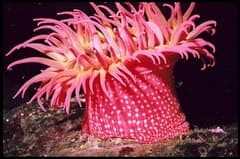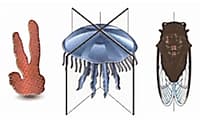Observe the animal below and answer the following question.

What type of symmetry does this animal exhibit? (Answer only in single word)

Important Questions on Patterns
Match the following
| List - I | List - II | ||
| (a) | Asymmetry | (i) | Cnidaria |
| (b) | Radial symmetry | (ii) | Platyhelminthes |
| (c) | Bilateral symmetry and Enterocoelom | (iii) | Porifera |
| (d) | Bilateral symmetry without body cavity | (iv) | Hemichordata |
The correct answer is
Observe and identify body symmetry of given animals:

An acoelomate animal with bilateral symmetry is
Some characters are given below:
i. Bilaterally symmetrical
ii. Triploblastic
iii. Segmented
iv. Coelomates
Which of the two phyla is characterized by the above all characters?
A bilaterally symmetrical animal can be divided into mirror images by
The radial symmetry is observed in:
I. Platyhelminthes
II. Coelenterates
III. Aschelminthes
IV. Annelids
V. Echinoderms
| Column I | Column II |
| A. Asymmetry | 1. Annelida |
| B. Radial Symmetry | 2. Ctenophora |
| C. Biradial Symmetry | 3. Cnidaria |
| D. Bilateral Symmetry | 4. Porifera |
Represent the union of two sets by Venn diagram for each of the following.
is a prime number between and
is an odd number between and
Consider the following statements (A - C) each with two blanks.
A. Animals like Hydra and jelly fish depict (i)___ symmetry whereas earthworm and leech show (ii)____ symmetry.
B. In (iii)____ and (iv)_____ digestive tract has only single opening (mouth) and is said to be incomplete.
C. Trichinella (Trichina worm) Is a cosmopolitan (v)_____ parasite whereas Fasciola, (liver fluke) lives in the bile ducts of the liver of (vi)____.
Which one of the following options, correctly fills any two statements?
Radial symmetry is seen in
| Animals | Symmetry | Organisation | Coelom type | |
|---|---|---|---|---|
| (i) | Ctenophores | Radial | Diploblastic | Pesudo-coelomates |
| (ii) | Echinoderms | Bilateral | Triploblastic | Coelomates |
| (iii) | Platyhelminthes | Bilateral | Triploblastic | Acoelomates |
| (iv) | Annelids | Biradial | Diploblastic | Coelomates |
Organisms, attached to substratum generally possess
Animals are classified based on their symmetry into ..... groups.

